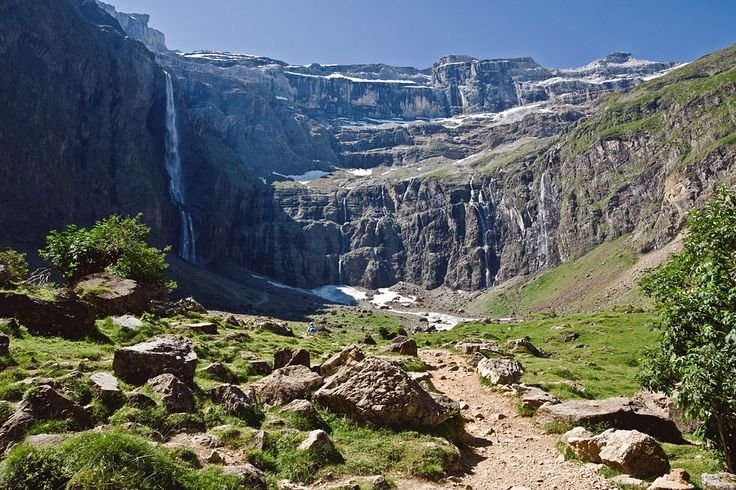The Sites & Sights of Occitanie
Occitanie, the southernmost region in mainland France, was created in 2016 from the Languedoc-Roussillon and Midi-Pyrénées regions. Occitanie is part of a larger historical region in southern Europe called Occitania, where the Occitan language is spoken, and encompasses France, Spain, Monaco, and parts of Italy. Bordered by the Mediterranean to the southeast, Côte d’Azur to the east, and the borders of Andorra and Spain in the south, its major cities include Montpelier, Perpignan, and Toulouse, the capital. The area has a rich and vibrant history shaped by the Romans, Moors, and Celtics.
It’s no wonder the locals have a reputation for being bons vivants who embody the joie de vivre. This region has something for everyone. For the lounger? Lay out on the beach, soak in thermal spas, or tour vineyards, museums, castles, and medieval villages. For the thrill seeker? Climb, hike, or ski the mountains, white water raft, or explore the region’s many caves.
Beyond the main cities, we’ve found some pretty cool sites and sights in the region, many of them designated as UNESCO World Heritage Sites.
sight-see in cities…
Nîmes
Nîmes, known as the French Rome, was a Celtic city around 500 BC until it joined the Roman Empire in the first century BC. Famous Roman architecture include the Arena of Nîmes, Maison Carrée, and Pont du Gard. One other significant site of the city is Jardin de la Fontaine, a park with Baroque sculptures and ornate canals and paths. Built 50 years after Versailles, it was the first grand gardens meant for the public and not for a king.
This city might just ask the question, “How often do you think of the Roman Empire?” For the people of Nîmes, it’s likely everyday.
Maison Carrée
Meaning Square House before they had the word for rectangle, this temple was built in 19 BCE dedicated to the presumptive heirs of Augustus. It was built as a testament to the moment of unification of the territory of Ancient Rome and the transition from republic to empire. It has survived because of its constant use for the past 1000 years — from temple to church to city hall to an art gallery after the Revolution — and now as a monument. Restoration since the 17th century has helped preserve its original form without major structural changes. It’s listed on the UNESCO World Heritage site.
Pont du Gard
A 30-mile long aqueduct was built in 19 BC to bring water to the growing population of Nîmes. Most of the aqueduct is on or below ground, but one stretch of it is the Pont du Gard, a bridge that stretches over the Gardon River outside of Nîmes. It’s one of the most remarkable surviving Roman ruins anywhere. The stones were cut to fit perfectly together without mortar and was designed to slope ever so slightly (less than an inch every hundred yards). The aqueduct ends at the castellum, the distribution tank with holes to carry water throughout the city via stone and lead pipes. The lower channel served top-priority needs, suppling water to the public wells in neighborhood squares while the higher holes would only be used when the water level was high enough. These directed water into the homes of the wealthy and public baths.
The Arena of Nîmes
Built in the 1st or 2nd century AD (the same time as the Colosseum of Rome), this amphitheatre is the best-preserved Roman arena in France. It’s a superb example of Roman engineering with its perfect symmetrical oval shape. Features include 60 arches on each of the two levels, 34 rows of seats to accommodate 20,000 people, 60 passageways to prevent bottlenecks, 126 staircases, and a system of underground rooms with a lift used to hoist animals up to the floor for gladiator games. After the Roman fall, the arena was used as a fortress by the Visigoths as it was easy to defend. In the Middle Ages, houses and a church were built inside. In 1809, the arena was cleared of buildings, and it was once again used for bullfights. Today, it’s used for concerts, tourism, and the annual Féria de Pentecôte, a Spanish-inspired bullfighting festival.
albi
Albi sits on the Tarn River, northeast of Toulouse, and is known for its sienna-tone brick buildings and half-timbered houses. The first settlement was in the Bronze Age in 3000-600 BC before becoming a Roman settlement.
The episcopal city was added to the UNESCO World Heritage Sites in 2010, Sainte-Cécile Cathedral, Saint-Salvi quarter and collegiate church, Pont-Vieux (the Old Bridge), and Berbie Palace which now houses the Musée Toulouse-Lautrec. The main draw is the Cathédrale Sainte-Cécile, which looms over the town. It’s the largest brick cathedral in the world and was built between the 13th and 15th centuries in the Southern Gothic style.
medieval fairytale villages
There are many medieval villages in the Occitanie region that have been well-preserved throughout history.
For a day trip, explore Carcassonne, a medieval walled city. Upper Town is located in the city’s defenses while the Lower Town is outside the walls. It was added to the UNESCO World Heritage Sites in 1997 because of the excellent preservation and restoration of the medieval citadel. The city relies heavily on tourism which can make for crowded days but the evenings are quiet.
Saint-Cirq-Lapopie is a member of the association of the most beautiful villages in France (Les Plus Beaux Villages de France). It sits 100 meter above the Lot River, originally selected for defense. It’s a popular destination as the entire town could pass as a museum.
Built between 1222 and 1229, Cordes-sur-Ciel is a small medieval village perched in the sky. You can only reach this village by walking up stone streets. It’s known for its outdoor market and home to the Museum of the Art of Sugar and Chocolate, which contains art made out of sugar (its giving Minnesota State Fair Seed Art vibes).
sight-see in NATURE…
Cirque de Garvarnie
The Cirque de Garvarnie is a cirque in the central Pyrenees, close to the border of Spain. A cirque is a natural amphitheatre-like valley formed by glacial erosion. This one is exceptionally large, likely due to repeated cycles of glacial scraping over millions of years. Victor Hugo described it as the “Colosseum of nature.” A number of waterfalls occur during the warmer months, including Gavarnie Falls, the second highest waterfall in Europe. It descends 422 meters over a series of steps before reaching the floor of the cirque.
It’s been on the UNESCO World Heritage list since 1997 on the basis of natural and cultural criteria. This is extremely rare as only a handful of sites benefit from this double distinction, such as Mount Taishan in China and the Sanctuary of Machu Picchu in Peru. It is also the only French site to be classified in this category.
Both Spain and France have national parks on both sides of the Pyrenees in this area, protecting a number of rare plants and animals. Flowers like martagon lilies and saxigraga grow in addition to other alpine wildflowers. Chamois, a goat-antelope, roam the crags. Hiking trails and horseback riding are common ways to explore this massive cirque.
the caves of the region
Padirac Cave
Descend 103 meters down a chasm before touring this natural limestone cave system by boat on the subterranean river. The river leads to underground lakes, vast galleries, and La Grande Pendeloque, a 60 meter long stalactite. The cave system is more than 25 miles, but only about 1 mile has been opened for tourism. It’s one of the most famous caves in Europe and a must see if in the Dordogne Valley.
Cave of Niaux
This complex cave system is more than 8 miles of underground passages and chambers, but most known for its Magdalenian period paintings of bison, horses, ibex, and deer. It holds prehistoric footprints and a rare charcoal sketch of a weasel.
Santiago de Compostela routes
Beginning in the 9th century, these routes were used by pilgrims headed to Santiago de Compostela in Spain, where tradition holds that the remains of the apostle James was buried. The pilgrimage to the shrine became the most renowned medieval pilgrimmage, and it was customary to return with a Galician scallop shell as proof of the journey.
The four main routes in France are Via Turonensis, Via Lemovicensis, Via Podiensis, and Via Tolosana. Via Tolosana goes through the Occitanie region with 29 sites listed as UNESCO World Heritage Sites, including monuments, churches, or hospitals that provided services to pilgrims. The paths, marked by a scallop shell, are still used by those on spirtual journeys, hikers, cyclists, and organized tour groups.













